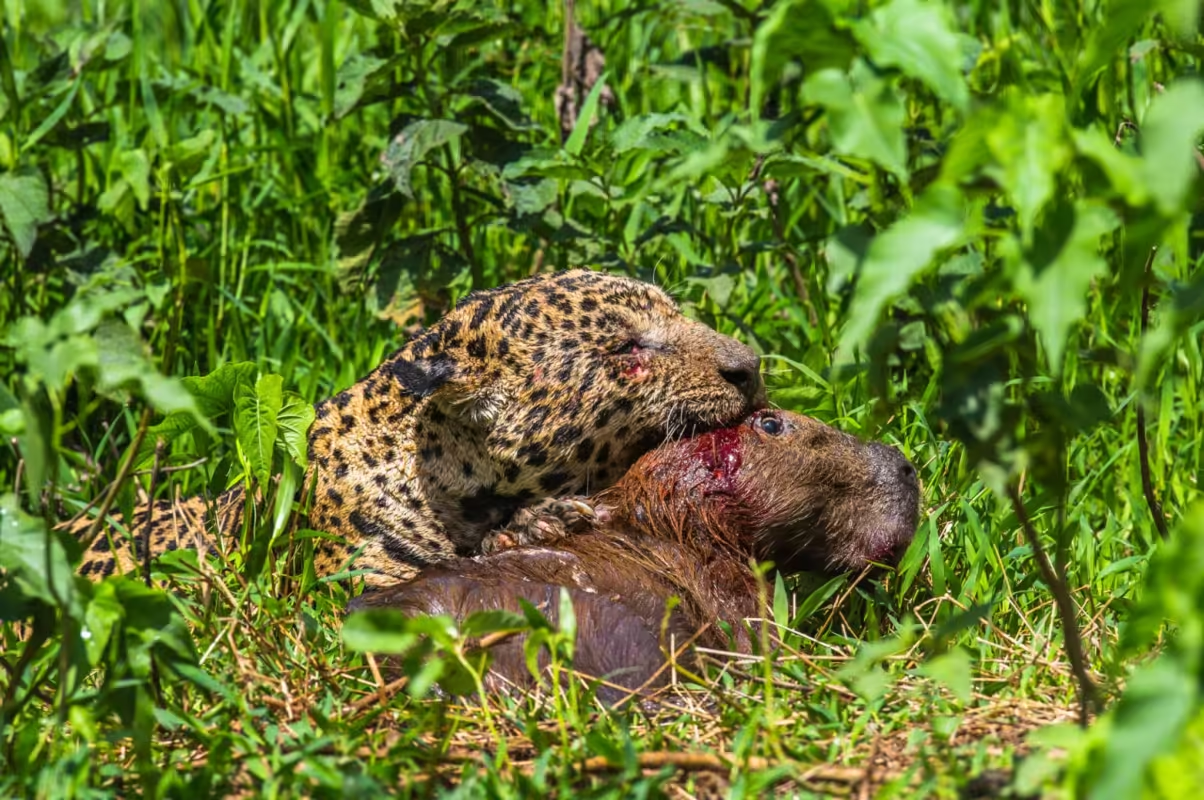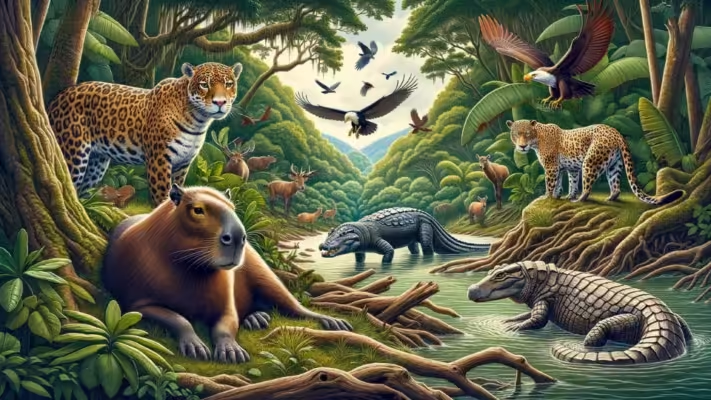Capybaras are well adapted to aquatic environments, thanks to their partially webbed feet, which help them navigate through water and swampy areas. Much like a hippopotamus, their eyes, nose, and ears are positioned on the top of their head, allowing them to stay mostly submerged while keeping an eye out for predators and taking in air, all while remaining largely concealed beneath the water’s surface.
A. Brief Overview of Capybaras Capybaras (Hydrochoerus hydrochaeris) are the largest rodents in the world and are native to South America. They inhabit various aquatic environments such as rivers, lakes, and marshes, and are known for their semi-aquatic lifestyle. Capybaras are herbivores, feeding primarily on grasses and aquatic plants. They are social animals, often found in large groups, and play important ecological roles in their habitats.
B. Importance of Understanding Capybara Predators Understanding capybara predators is crucial for several reasons. Firstly, it sheds light on the complex predator-prey dynamics within ecosystems where capybaras reside. Additionally, knowledge of capybara predators is essential for conservation efforts to preserve both capybara populations and their ecosystems. By understanding the threats posed by predators, conservationists can develop strategies to mitigate these risks and ensure the survival of capybaras and their habitats.
Capybara Habitat and Behavior
A. Description of Capybara Habitat Capybaras inhabit a range of aquatic environments, including rivers, lakes, marshes, and wetlands. They are commonly found in regions of South America, such as the Amazon Basin, the Pantanal, and the Orinoco Basin. These habitats provide capybaras with access to water for swimming and feeding, as well as ample vegetation for grazing.
B. Social Behavior and Group Dynamics Capybaras are highly social animals and are often found living in large groups known as “herds” or “groups.” These groups can consist of anywhere from 10 to 100 individuals, although smaller groups are also common. Capybaras exhibit complex social behaviors within these groups, including grooming, vocal communication, and cooperative defense against predators.
C. Factors That Make Capybaras Vulnerable to Predation Despite their size and social structure, capybaras are vulnerable to predation from a variety of predators. Factors that contribute to their vulnerability include their relatively slow movement on land, their large size making them conspicuous targets, and their reliance on water sources for safety, which can also attract predators. Additionally, factors such as habitat loss and fragmentation can further increase their susceptibility to predation by reducing available cover and increasing human-wildlife conflicts.
Natural Predators of Capybaras
A. Jaguars Jaguars (Panthera onca) are apex predators known for their strength and agility. They primarily hunt by ambush, relying on their powerful jaws to deliver a fatal bite to their prey. Capybaras are among the preferred prey of jaguars, especially in areas where the two species coexist. Jaguars often target capybaras when they come to drink or graze near water bodies.
B. Pumas Pumas (Puma concolor), also known as cougars or mountain lions, are solitary predators found throughout the Americas. While they typically prey on smaller animals like deer and rodents, they are known to opportunistically target capybaras, especially juveniles or individuals who stray from the safety of their groups. Pumas use stealth and agility to ambush their prey, making capybaras vulnerable, particularly in areas with dense vegetation.
C. Anacondas Green anacondas (Eunectes murinus) are the largest snakes in the world and are capable of preying on capybaras, particularly juveniles or smaller adults. Anacondas are excellent swimmers and ambush predators, often lying in wait near water bodies frequented by capybaras. With their powerful constriction, anacondas can overpower and suffocate their prey before swallowing them whole.
D. Large Birds of Prey (e.g., Harpy Eagles) Large birds of prey, such as harpy eagles (Harpia harpyja), pose a threat to capybaras, particularly younger individuals or those who are sick or injured. Harpy eagles are powerful raptors known for their strong talons and keen eyesight. They hunt by swooping down from the sky to catch their prey, which may include capybaras foraging in open areas or along riverbanks.
E. Other Potential Predators (e.g., Caimans, Ocelots) Capybaras face predation from a variety of other carnivores in their habitat, including caimans (crocodilians) and ocelots (small wild cats). Caimans, particularly larger species like the black caiman (Melanosuchus niger), may prey on capybaras, especially when they venture too close to the water’s edge. Ocelots, agile and stealthy hunters, may target capybaras in areas with dense vegetation or during times of vulnerability, such as when capybaras are giving birth or caring for young. These predators contribute to the natural mortality of capybaras in their ecosystem.
Predator-Prey Interactions
A. Hunting Strategies Employed by Capybara Predators
- Ambush Predation: Predators like jaguars and pumas utilize stealth and camouflage to ambush capybaras, often near water sources or areas with dense vegetation.
- Pursuit Predation: Predators such as harpy eagles and anacondas employ pursuit tactics, using their speed or aerial advantage to chase down capybaras.
- Cooperative Hunting: Some predators, like packs of ocelots or groups of caimans, may cooperate to increase their chances of capturing capybaras, especially in situations where prey is larger or more challenging to subdue.
B. Defense Mechanisms of Capybaras
- Group Vigilance: Capybaras rely on safety in numbers, with members of the group actively scanning their surroundings for potential threats while others feed or rest.
- Alarm Calls: Capybaras communicate using various vocalizations, including alarm calls that warn group members of approaching danger, allowing them to take evasive action.
- Vigorous Defense: When confronted by a predator, capybaras may defend themselves or their young by standing their ground, vocalizing loudly, or using their sharp incisors to bite back.
C. How Capybaras Minimize Predation Risk
- Utilizing Water as Refuge: Capybaras retreat to water bodies when threatened, using their excellent swimming ability to evade terrestrial predators.
- Choosing Safe Habitats: Capybaras select habitats with dense vegetation or ample cover, reducing their visibility to predators and providing escape routes if needed.
- Behavioral Adaptations: Capybaras adjust their activity patterns based on perceived risk, such as avoiding areas with recent predator sightings or altering their foraging behavior to minimize exposure to danger.
Human Impact on Capybara Predators
A. Habitat Destruction and Fragmentation
- Deforestation: Human activities such as logging, agriculture, and urbanization destroy capybara habitats, reducing the availability of suitable habitats for both capybaras and their predators.
- Fragmentation: Fragmentation of habitats due to infrastructure development, such as roads and dams, isolates populations of capybaras and their predators, disrupting natural predator-prey dynamics and reducing genetic connectivity.
B. Hunting Pressure on Capybara Predators
- Direct Hunting: Humans directly hunt capybara predators for various purposes, including trophy hunting, fur trade, and traditional medicine, leading to declines in predator populations.
- Indirect Effects: The hunting of other species may indirectly impact capybara predators by altering the availability of alternative prey or disrupting food chains and ecosystem dynamics.
C. Indirect Effects
- Decline of Predator Populations: Human activities such as hunting and habitat destruction can lead to reductions in predator populations, which may have cascading effects on ecosystems. Decreases in predator abundance can disrupt predator-prey relationships, leading to imbalances in prey populations and potentially affecting ecosystem stability.
- Ecological Imbalance: The decline of capybara predators can result in unchecked population growth of capybaras and other herbivores, leading to overgrazing, habitat degradation, and loss of biodiversity. This imbalance can have far-reaching consequences for ecosystem health and functioning.
Conservation Efforts
A. Importance of Protecting Capybara Habitats
- Preserving Biodiversity: Capybara habitats support diverse ecosystems with numerous plant and animal species, and protecting these habitats helps maintain biodiversity.
- Ensuring Capybara Survival: Healthy habitats provide essential resources such as food, water, and shelter for capybaras, contributing to their long-term survival.
- Ecological Services: Capybara habitats provide valuable ecological services, including water filtration, flood control, and carbon sequestration, benefiting both wildlife and humans.
B. Implementing Measures to Mitigate Human Impacts on Capybara Predators
- Habitat Restoration: Efforts to restore degraded habitats and create wildlife corridors can help reconnect fragmented populations of capybaras and their predators, promoting natural predator-prey interactions.
- Regulation of Hunting: Implementing and enforcing regulations on hunting and trapping of capybara predators helps prevent overexploitation and supports sustainable management of wildlife populations.
- Education and Outreach: Educating local communities about the importance of coexisting with wildlife and the role of predators in ecosystems can foster attitudes of conservation and reduce human-wildlife conflicts.
C. Research Initiatives Aimed at Understanding Predator-Prey Dynamics
- Monitoring Populations: Conducting population surveys and monitoring programs for capybaras and their predators helps assess population trends, identify threats, and inform conservation strategies.
- Studying Behavior: Research on the behavior and ecology of capybaras and their predators provides insights into predator-prey interactions, including hunting strategies, defense mechanisms, and habitat preferences.
- Modeling Ecosystem Dynamics: Using ecological models to simulate predator-prey dynamics in capybara habitats helps predict the impacts of environmental changes and human activities on wildlife populations, guiding conservation efforts and policy decisions.
What to know
A. Recap of Key Points Regarding Capybara Predators
- Capybaras face predation from various predators including jaguars, pumas, anacondas, large birds of prey, and other carnivores.
- Predator-prey interactions involve various hunting strategies employed by predators and defense mechanisms utilized by capybaras.
- Human activities such as habitat destruction, hunting pressure, and indirect effects contribute to the decline of capybara predators and disrupt natural ecosystems.
B. Emphasis on the Need for Conservation Efforts to Ensure the Survival of Capybaras and Their Predators
- Conservation efforts should focus on protecting capybara habitats, implementing measures to mitigate human impacts on capybara predators, and promoting coexistence between humans and wildlife.
- Ensuring the survival of capybaras and their predators is essential for maintaining ecosystem balance, biodiversity, and the integrity of natural habitats.
C. Call to Action for Further Research and Conservation Initiatives
- Continued research is needed to better understand predator-prey dynamics, habitat requirements, and conservation needs of capybaras and their predators.
- Conservation initiatives should prioritize collaborative efforts involving government agencies, conservation organizations, local communities, and stakeholders to address threats to capybara populations and their predators.
- Individuals can contribute to conservation efforts by supporting sustainable practices, advocating for habitat protection, and participating in citizen science projects that monitor wildlife populations and ecosystem health.



